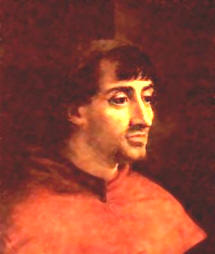 After Adrian, another
Medici. At the conclave Leo's cousin Giulio won the tiara after stubborn
competition from cardinals Farnese and Wolsey. He took the name Clement VII.
Giulio de' Medici was born in Florence in 1478.
After Adrian, another
Medici. At the conclave Leo's cousin Giulio won the tiara after stubborn
competition from cardinals Farnese and Wolsey. He took the name Clement VII.
Giulio de' Medici was born in Florence in 1478.
Created cardinal in 1513, he was considered the architect of Leo's foreign
policy. Giulio was a handsome man of good morals, and quite free from the
frivolity of Leo X, but he was not very able and was tortured with a dangerous
inability to make up his mind. In short, he was scarcely the pope for troubled
times. Two tragedies mark the reign of this second Medici pope: the sack of Rome
and the loss of England. After trying vainly to bring about peace between the
Emperor and Francis I, Clement, unlucky and improvident, made an alliance with
the French even as they were on the march for Pavia and disaster.
The Emperor, really angry, made himself disagreeable to the Pope. Clement,
frightened more than ever, formed the League of Cognac against him. In return
the imperialists egged on the Colonna to make trouble for the Pope. These
ruffians burst into Rome, sacked the Vatican, and desecrated St. Peter's, a grim
prelude to next year's frightful tragedy. The next year, 1527, the imperialist
army in North Italy, infuriated by lack of pay and longing for plunder, marched
south. Florence, threatened, was saved by the Cognac League Army. The
mercenaries, however, had fixed their greedy eyes on a greater prey, rich Rome
itself. Abandoning even their guns, the motley horde of Spaniards, Italians, and
Germans hastened toward the city. On May 5, even without artillery, the wild
throng broke through the feeble defenses of the papal capital. Clement, who had
only just reached the safety of the Castle of St. Angelo, had to listen to the
agonized screams of his poor flock.
A nightmare followed as pikemen butchered men, women, and children, plundered
and desecrated to their hearts' content. The glory of Renaissance Rome was
extinguished in blood. Clement finally made peace with the Emperor, indeed, even
crowned him at Bologna in 1530; but a greater disaster than the sacking of Rome
was in the making. Henry VIII of England had written against Luther, and even in
politics was quite pro-papal; but a lustful attachment to Anne Boleyn showed how
weak his principles were. Eagerly he bombarded Clement with requests for an
annulment of his marriage with Catharine of Aragon. Clement, reluctant to
displease the friendly monarch and hoping that something would turn up to change
the situation, stalled and delayed. But he was waiting for a break that never
came, and when all the facts were in, there was only one decision possible: that
Henry's was a good marriage. Henry did not wait for the final decision. In 1534
he climaxed a series of anti-Catholic acts by forcing the Church in England to
break from Catholic unity.
Clement VII died shortly after on September 26, 1534.
Excerpted from "Popes
Through the Ages" by Joseph Brusher, S.J.

